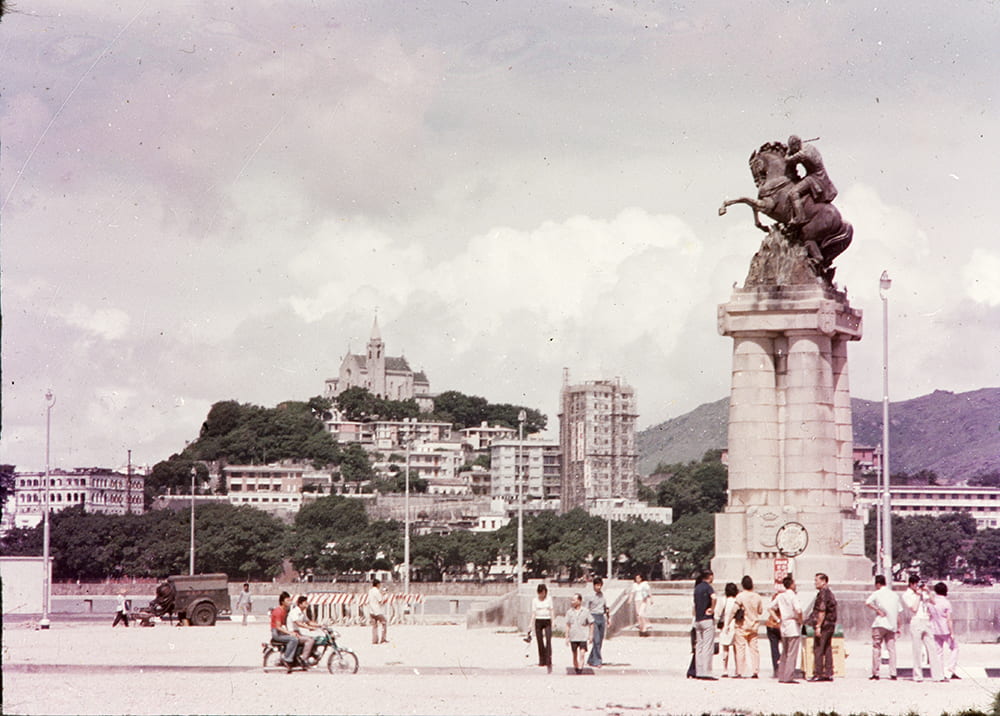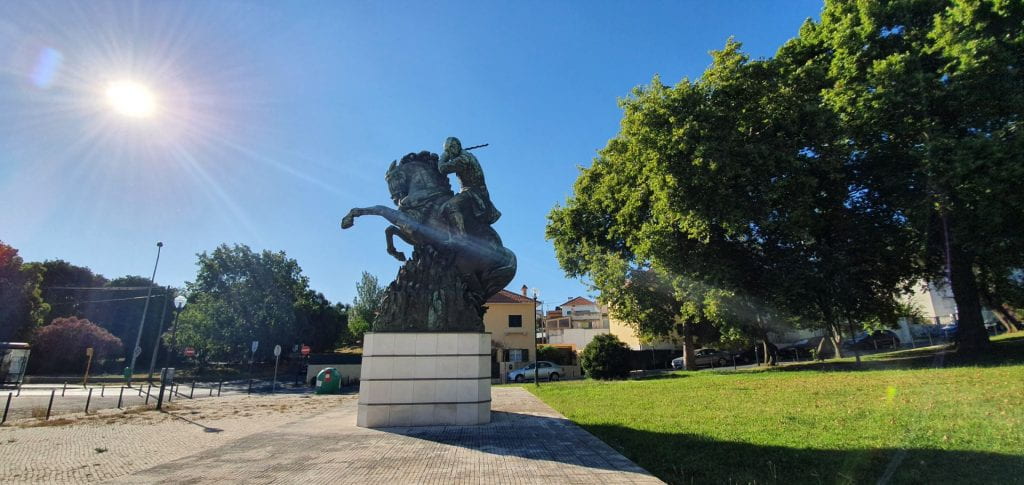Dr. Helena F. S. Lopes is a Leverhulme Early Career Research Fellow at the Department of History, University of Bristol. This posting is part two of three-part series on the ruins of Macau. Part one can be read here.

Ferreira do Amaral statue, Macau, c. 1975. HPC ref: Aw-t524.
In one of the ‘20 Colour Slides Of Macau Scenery’ (c. 1970s) in the Colin and Janet Andrew Collection held at the University of Bristol Special Collections (DM2818/3), sharing promotional space with old temples and new hotels, one finds a site of crucial importance to discussions on ‘disappearance’ and public commemoration of Macau’s colonial past: the controversial statue of João Maria Ferreira do Amaral.
A Portuguese naval officer, Amaral served as governor of Macau from 1846 until 1849. He undertook a series of measures aimed at curbing Chinese power in the territory and asserting Portuguese colonial control. From closing down Chinese customs houses to clearing graves to build roads, his actions met with fierce Chinese resistance which led to his killing in 1849 outside the Macau border. His death escalated tensions between Chinese and Portuguese authorities, which reached the point of military confrontation. Macanese army officer Vicente Nicolau de Mesquita played a leading role in ensuring a quick Portuguese victory with significantly outnumbered forces in the Passaleão/Baishaling incident. Amaral and Mesquita have remained divisive figures: hailed as colonial heroes by some, criticised as colonial oppressors by others.[1]
In 1940, almost a century after Amaral’s assassination, bronze statues of the two men were installed in Macau. At the time, China grappled with the overwhelming effects of the War of Resistance against Japan while the Portuguese Estado Novo dictatorship, capitalising on its Second Word War neutrality, celebrated its imperial history in an international exhibition in Lisbon (the Portuguese World Exhibition, whose architectural legacy remains highly visible today). The placing of these statues in prime locations in Macau (Mesquita’s near Leal Senado, Amaral in a square named after him near where the Hotel Lisboa and the Bank of China skyscraper would later be built) in this particular context has been seen as a way ‘to secure the territory’s neutrality through the means of re-affirming a Portuguese identity.’[2] A more critical reading would, however, note the symbolic act of colonial humiliation at a time when Chinese anti-imperialist activism had more pressing targets. By 1940, Macau – itself a site where the Chinese anti-Japanese resistance was active – was no stranger to the massive disruption caused by the Japanese invasion of China. A significant number of Chinese refugees moved to the neutral territory during the conflict.
The statues of Amaral and Mesquita, by Portuguese sculptor Maximiano Alves, showed the men engaged in positions which seem to glorify, with masculine assertiveness, their role as defenders, by violence if necessary, of Portuguese colonial rule in Macau: Amaral riding a horse while brandishing a whip to, according to an information plaque in the statue’s current location ‘defend himself against his aggressors’; Mesquita drawing his sword while standing. They stand alone, their opponents invisible. Yet not a century went by before their presence was deemed too uncomfortable to remain standing in a post-colonial Macau. Mesquita’s statue was removed first, in the late 1966 clashes that saw Portuguese colonial authority in Macau contested and constrained in events whose wider context had links to the Cultural Revolution in the mainland (but which had specific local dynamics as well). A photograph taken the year before the statue’s toppling can be seen here. Amaral’s statue remained in place beyond the 1960s, but was dismantled in 1992 and shipped to Lisbon, at the request of the then director of Hong Kong and Macao Affairs Office of the State Council of the People’s Republic of China. The decision to remove the statue before the handover and the figure of Amaral as a symbol of contrasting perspectives on the territory continues to generate discussions and being reimagined in cultural productions (for example novels and an opera).[3]
When the monument was removed, it seems to have been for many just a statue of ‘a guy on a horse’ located in a square where people could stroll and gather together regardless (rather than because) of the figure being commemorated.[4] Indeed, the photograph above shows people riding pass it or congregating in groups. In the background we see the Penha Hill, with Our Lady of Penha Chapel (Capela de Nossa Senhora da Penha) on top (first built in the seventeenth century, the present-day building dating from 1935).
Earlier this year, Amaral’s name came up when an advisor to the Municipal Affairs Bureau in Macau suggested changing street names associated with the Portuguese colonial period – attracting some pushback.[5] In Lisbon, Amaral’s statue was not put in storage nor exhibited in a museum but is on public display, in a small garden in a residential neighbourhood. It appears to remain fairly unnoticed. One should not overlook the power of indifference to rejecting the statue’s original celebratory purpose – perhaps that too is a peculiar form of decolonisation.

Ferreira do Amaral statue, Lisbon, 2020. Photograph by Helena F. S. Lopes. © Helena F. S. Lopes.
[1] On the contrasting meanings of the statues for Chinese and Portuguese see C. M. B. Cheng, Macau: A Cultural Janus (Hong Kong: Hong Kong University Press, 1999), pp. 28-30.
[2] Paula Morais, ‘Macau’s Urban Transformation 1927-1949: The Significance of Sino-Portuguese Foreign Relations in the Urban Form’ in Izumi Kuroishi, ed., Constructing the Colonized Land: Entwined Perspectives of East Asia Around WWII (Surrey: Ashgate, 2014), p. 155.
[3] E.g. João Paulo Meneses, ‘A maldição da estátua de Ferreira do Amaral’ [The curse of Ferreira do Amaral’s statue], Ponto Final, 11 May 2011; Mário César Lugarinho, ‘Violência e Interpretação, Leituras da História de Macau’ [Violence and Interpretation, Readings of the History of Macau], Abril-Revista do Núcleo de Estudos de Literatura Portuguesa e Africana da UFF, 10/20 (2018), pp. 37-48.
[4] C. H. Clayton, Sovereignty at the Edge: Macau & the Question of Chineseness (Cambridge, MA: Harvard University Press, 2009), p. 212.
[5] On the meanings (and lack of them) of Macau’s official street names and multiple perceptions of architectural changes in Macau see Clayton’s Sovereignty at the Edge, Chapter Five.

